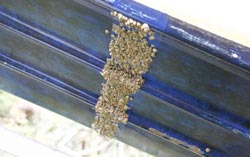A coating that prevents barnacles forming colonies

Part of the hull of a planing boat that has been painted with a copper-free TF paint with trace amounts of a macrocyclic lactone (Ivermectin). The broad stripe in the centre was painted with TF paint without additive. The boat was used in traffic on the western coast of Sweden for four months in the summer of 2009. Boat owner: Mauritz Palm. Photo: Mats Hulander<br>
Scientists at the University of Gothenburg have shown that it is instead possible to mix into the coating molecules on which the adult barnacles cannot grow. The result has been published in the scientific journal Biofouling.
Fouling of hulls is a problem for all boat owners, and one of the most difficult organisms to deal with is barnacles. A research group at the Department of Cell and Molecular Biology has therefore studied the biology of barnacles in detail, and focussed on one particularly sensitive stage in the barnacle life cycle.
“When newly matured adult barnacles attempt to penetrate through the coating in order to establish a fixed location to grow, they are extremely sensitive to certain molecules known as ‘macrocyclic lactones’, which are normally produced by certain bacteria”, says Professor Hans-Björne Elwing of the Department of Cell and Molecular Biology at the University of Gothenburg.
A better effect with no toxin released to the environment
When such molecules are mixed into the anti-fouling coating, the treated surface is first colonised by barnacles in the normal way. But as soon as the young barnacles have matured into adults and attempt to establish stronger contact with the surface, they lose contact and probably die. It is also the case that certain brown algae counteract the colonisation by barnacles on the surfaces of leaves in a similar manner.
“Using this discovery, we have managed to create coatings with new binding agents that shut down the release of the macrocyclic lactones into the marine environment. Further, only trace amounts of the macrocyclic lactones are required in the coating to give full effect against barnacles.”
The research group has shown through field trials on leisure craft that the addition of macrocyclic lactones can fully replace copper in coatings used on such craft, on both the eastern and the western coasts of Sweden, and for several seasons.
“While it is true that it is only barnacles that are affected by the additive, the growth of algae and similar organisms can be counteracted relatively simply by other methods.”
The study has been carried out by Emiliano Pinori, Mattias Berglin, Mats Hulander, Mia Dahlström and Hans Elwing at the University of Gothenburg, in collaboration with Lena Brive at the SP Technical Research Institute of Sweden in Borås. The article Multi-seasonal barnacle (Balanus improvisus) protection achieved by trace amounts of a macrocyclic lactone (ivermectin) included in rosin-based coatings has been published in the journal Biofouling.
Bibliographic data:
Title: Multi-seasonal barnacle (Balanus improvisus) protection achieved by trace amounts of a macrocyclic lactone (ivermectin) included in rosin-based coatings
Jounral: Biofouling
Authors: Emiliano Pinoriab, Mattias Berglina, Lena M. Briveb, Mats Hulandera, Mia Dahlströma & Hans Elwinga*
For further information, please contact:
Hans-Björne Elwing, Department of Cell and Molecular Biology, University of Gothenburg
Tel: +46 31 786 2562
Mobile: +46 733 604607
hans.elwing@cmb.gu.se
Media Contact
All latest news from the category: Materials Sciences
Materials management deals with the research, development, manufacturing and processing of raw and industrial materials. Key aspects here are biological and medical issues, which play an increasingly important role in this field.
innovations-report offers in-depth articles related to the development and application of materials and the structure and properties of new materials.
Newest articles

A universal framework for spatial biology
SpatialData is a freely accessible tool to unify and integrate data from different omics technologies accounting for spatial information, which can provide holistic insights into health and disease. Biological processes…

How complex biological processes arise
A $20 million grant from the U.S. National Science Foundation (NSF) will support the establishment and operation of the National Synthesis Center for Emergence in the Molecular and Cellular Sciences (NCEMS) at…

Airborne single-photon lidar system achieves high-resolution 3D imaging
Compact, low-power system opens doors for photon-efficient drone and satellite-based environmental monitoring and mapping. Researchers have developed a compact and lightweight single-photon airborne lidar system that can acquire high-resolution 3D…





















